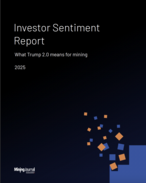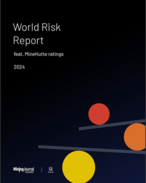| _pk_id.* | www.miningnews.net | / | 393 days | |
Used by Matomo to store a few details about the user such as the unique visitor ID |
| _ga | .miningnews.net | / | 400 days | |
Contains a unique identifier used by Google Analytics to determine that two distinct hits belong to the same user across browsing sessions. |
| _gid | .miningnews.net | / | 1 day | |
Contains a unique identifier used by Google Analytics to determine that two distinct hits belong to the same user across browsing sessions. |
| _fbp | .miningnews.net | / | 90 days | |
Facebook Pixel advertising first-party cookie. Used by Facebook to track visits across websites to deliver a series of advertisement products such as real time bidding from third party advertisers. |
| __cf_bm | .hubspot.com | / | 1 hour | 3rd party |
The __cf_bm cookie supports Cloudflare Bot Management by managing incoming traffic that matches criteria associated with bots. The cookie does not collect any personal data, and any information collected is subject to one-way encryption. |
| random_token | www.miningnews.net | / | 400 days | |
| access_type | www.miningnews.net | / | Session | |
| access_denied | www.miningnews.net | / | Session | |
| _gcl_au | .miningnews.net | / | 90 days | |
Used by Google AdSense to understand user interaction with the website by generating analytical data. |
| __hstc | .miningnews.net | / | 180 days | |
This cookie name is associated with websites built on the HubSpot platform. This is the main cookie for tracking visitors. It contains the domain, utk, initial timestamp (first visit), last timestamp (last visit), current timestamp (this visit), and session number (increments for each subsequent session). |
| hubspotutk | .miningnews.net | / | 180 days | |
This cookie name is associated with websites built on the HubSpot platform. This cookie is used to keep track of a visitor's identity. This cookie is passed to HubSpot on form submission and used when deduplicating contacts. |
| __hssrc | .miningnews.net | / | Session | |
This cookie name is associated with websites built on the HubSpot platform. Whenever HubSpot changes the session cookie, this cookie is also set to determine if the visitor has restarted their browser. If this cookie does not exist when HubSpot manages cookies, it is considered a new session. |
| __hssc | .miningnews.net | / | 1 hour | |
This cookie name is associated with websites built on the HubSpot platform. This cookie keeps track of sessions. This is used to determine if HubSpot should increment the session number and timestamps in the __hstc cookie. It contains the domain, viewCount (increments each pageView in a session), and session start timestamp. |
| _ga_* | .miningnews.net | / | 400 days | |
Contains a unique identifier used by Google Analytics 4 to determine that two distinct hits belong to the same user across browsing sessions. |
| __cf_bm | .js.ubembed.com | / | 1 hour | 3rd party |
The __cf_bm cookie supports Cloudflare Bot Management by managing incoming traffic that matches criteria associated with bots. The cookie does not collect any personal data, and any information collected is subject to one-way encryption. |
| cookiehub | .miningnews.net | / | 365 days | |
Used by CookieHub to store information about whether visitors have given or declined the use of cookie categories used on the site. |
| _cfuvid | .hubspot.com | / | Session | 3rd party |
Used by Cloudflare WAF to distinguish individual users who share the same IP address and apply rate limits |
| _wps2023_session | www.miningnews.net | / | Session | |
| ep201 | .wufoo.com | / | 1 hour | 3rd party |
| _splunk_rum_sid | aspermontuk.wufoo.com | / | 1 hour | 3rd party |
| _pk_ses.* | www.miningnews.net | / | 1 hour | |
Short lived cookies used by Matomo to temporarily store data for the visit |
| _gat_* | .miningnews.net | / | 1 hour | |
Used by Google Analytics to throttle request rate (limit the collection of data on high traffic sites) |
| UserMatchHistory | .linkedin.com | / | 30 days | 3rd party |
Contains a unique identifier used by LinkedIn to determine that two distinct hits belong to the same user across browsing sessions. |
| AnalyticsSyncHistory | .linkedin.com | / | 30 days | 3rd party |
Used by LinkedIn to store information about the time a sync with the lms_analytics cookie took place for users in the Designated Countries |
| bscookie | .www.linkedin.com | / | 365 days | 3rd party |
Used by the social networking service, LinkedIn, for tracking the use of embedded services. |
| _cfuvid | .hsforms.com | / | Session | 3rd party |
Used by Cloudflare WAF to distinguish individual users who share the same IP address and apply rate limits |
| __cf_bm | .hsforms.net | / | 1 hour | 3rd party |
The __cf_bm cookie supports Cloudflare Bot Management by managing incoming traffic that matches criteria associated with bots. The cookie does not collect any personal data, and any information collected is subject to one-way encryption. |
| __cf_bm | .hsforms.com | / | 1 hour | 3rd party |
The __cf_bm cookie supports Cloudflare Bot Management by managing incoming traffic that matches criteria associated with bots. The cookie does not collect any personal data, and any information collected is subject to one-way encryption. |
| YSC | .youtube.com | / | Session | 3rd party |
This cookie is set by YouTube video service on pages with YouTube embedded videos to track views. |
| VISITOR_INFO1_LIVE | .youtube.com | / | 180 days | 3rd party |
Set by YouTube and used for various purposes, including analytical and advertising. |
| VISITOR_PRIVACY_METADATA | .youtube.com | / | 180 days | 3rd party |
| __cf_bm | .hs-scripts.com | / | 1 hour | 3rd party |
The __cf_bm cookie supports Cloudflare Bot Management by managing incoming traffic that matches criteria associated with bots. The cookie does not collect any personal data, and any information collected is subject to one-way encryption. |
| __cf_bm | .hsadspixel.net | / | 1 hour | 3rd party |
The __cf_bm cookie supports Cloudflare Bot Management by managing incoming traffic that matches criteria associated with bots. The cookie does not collect any personal data, and any information collected is subject to one-way encryption. |
| __cf_bm | .hs-analytics.net | / | 1 hour | 3rd party |
The __cf_bm cookie supports Cloudflare Bot Management by managing incoming traffic that matches criteria associated with bots. The cookie does not collect any personal data, and any information collected is subject to one-way encryption. |
| __cf_bm | .hs-banner.com | / | 1 hour | 3rd party |
The __cf_bm cookie supports Cloudflare Bot Management by managing incoming traffic that matches criteria associated with bots. The cookie does not collect any personal data, and any information collected is subject to one-way encryption. |
| __cf_bm | .hs-sites.com | / | 1 hour | 3rd party |
The __cf_bm cookie supports Cloudflare Bot Management by managing incoming traffic that matches criteria associated with bots. The cookie does not collect any personal data, and any information collected is subject to one-way encryption. |
| __cf_bm | .hsappstatic.net | / | 1 hour | 3rd party |
The __cf_bm cookie supports Cloudflare Bot Management by managing incoming traffic that matches criteria associated with bots. The cookie does not collect any personal data, and any information collected is subject to one-way encryption. |
| __cf_bm | .hubspotusercontent-na1.net | / | 1 hour | 3rd party |
The __cf_bm cookie supports Cloudflare Bot Management by managing incoming traffic that matches criteria associated with bots. The cookie does not collect any personal data, and any information collected is subject to one-way encryption. |
| __cf_bm | .d6b07ab580ee4097b04bbf7de7b940b8.pages.ubembed.com | / | 1 hour | 3rd party |
The __cf_bm cookie supports Cloudflare Bot Management by managing incoming traffic that matches criteria associated with bots. The cookie does not collect any personal data, and any information collected is subject to one-way encryption. |























